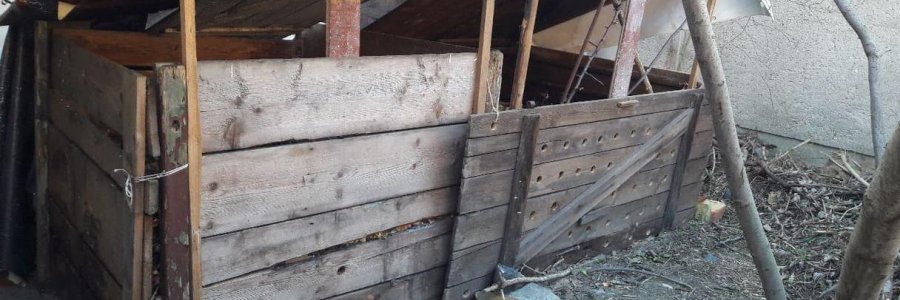Some say the compost is a garden's heart. Physically speaking this doesn't apply to our compost. Hidden in a shady corner our compost is growing behind wild elder and various scrubs which provides shelter for birds and insects.
Since the saved food can't be used 100%, everything from the apple core to zucchini rests ends on up the compost. So no need to use the trash bins and we can already dream about nice humus for the beds.
You could think that it's quite easy to install and maintain a god and working compost. Well, it's not always that simple. We had to learn the hard way: many things can go wrong with a compost. Ours became anaerobic which slowed down the composting process.
So first some general information about composting: Tons of microorganisms, worms, fungi and bacteria help decomposing the organic matter during composting. This complex process consists of many different stages which all are characterized by specific organisms and temperatures. A compost can reach up to 70°C! Oxygen is also very important for all that life in the compost - a compost needs to be properly ventilated.
Our compost was made from old wooden boards that were nailed together with gaps to let air pass through. (Recently we found out that those gaps were too small - but I'll tell you about that later.) You want to mix in bigger pieces of drier material like straw, shredded wood, dry leaves, old veggie plants. A good arrangement in layers leads not only to good ventilation but also results in well-balanced, fertile soil. Straw and wood shreds have a high level of carbon, hay has a lot of nitrogen. Water is also very important. It often makes sense to cover a compost so that it doesn't get too wet. On the other hand it shouldn't completely dry out either since no composting can happen then.
Our compost which is located in a shady corner was not covered until recently and we were not very good in taking care of proper layers. On top of that ventilation was not sufficient due to the small air gaps and we ended up with rotting instead of composting. Food scraps were normally just added on top again and again. All this together resulted in a disgustingly rotting compost. A good compost shouldn't stink, it should smell like the kind of moist soil you can find in a forest. Well ours did stink. Rot also leads to the composting process being very much decelerated because the lack of oxygen prevents it to happen.
That's why we built a new compost next to the old one, this time with a lot of holes for better air flow and not as high as the last one. Then the unpleasant part of the work began: The old compost heap needed to be moved into the new construction. First I prepared it with a ground layer of branches of dry veggie plants, then I shifted the stinking, slimy mass over with a shovel - which was really exhausting.
By now we also built small roofs that protect the composts from rain. We also take care now to shred old wood and add it to the compost. Cardboard works, too, as long as it doesn't have plastic pieces on it.
We try to only put very few citrus fruit peels or banana peels on our compost. Right now it's the season for citrus fruits, so the compost would probably be overwhelmed by all the peels. The microbiome of the compost seems to not like those peels and they decompose much slower than other things. Prepared food that went bad is also not fit to be put on the compost as it could attract rats. Same for bread. Those things belong into the organic waste bin.
Now we'll give our old compost some time to rest and who knows, maybe in the next garden season we can already harvest awesome, rich humus!
